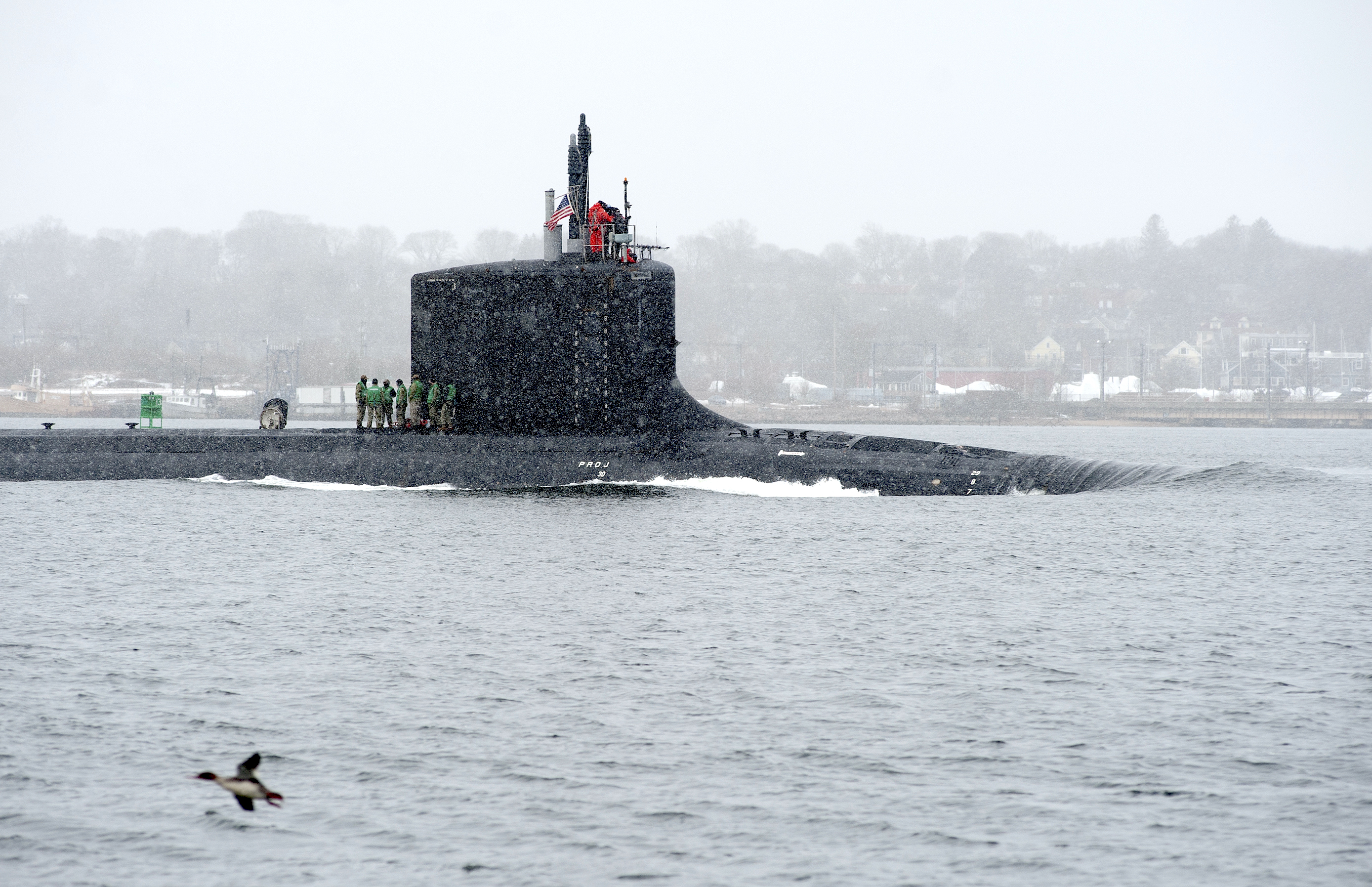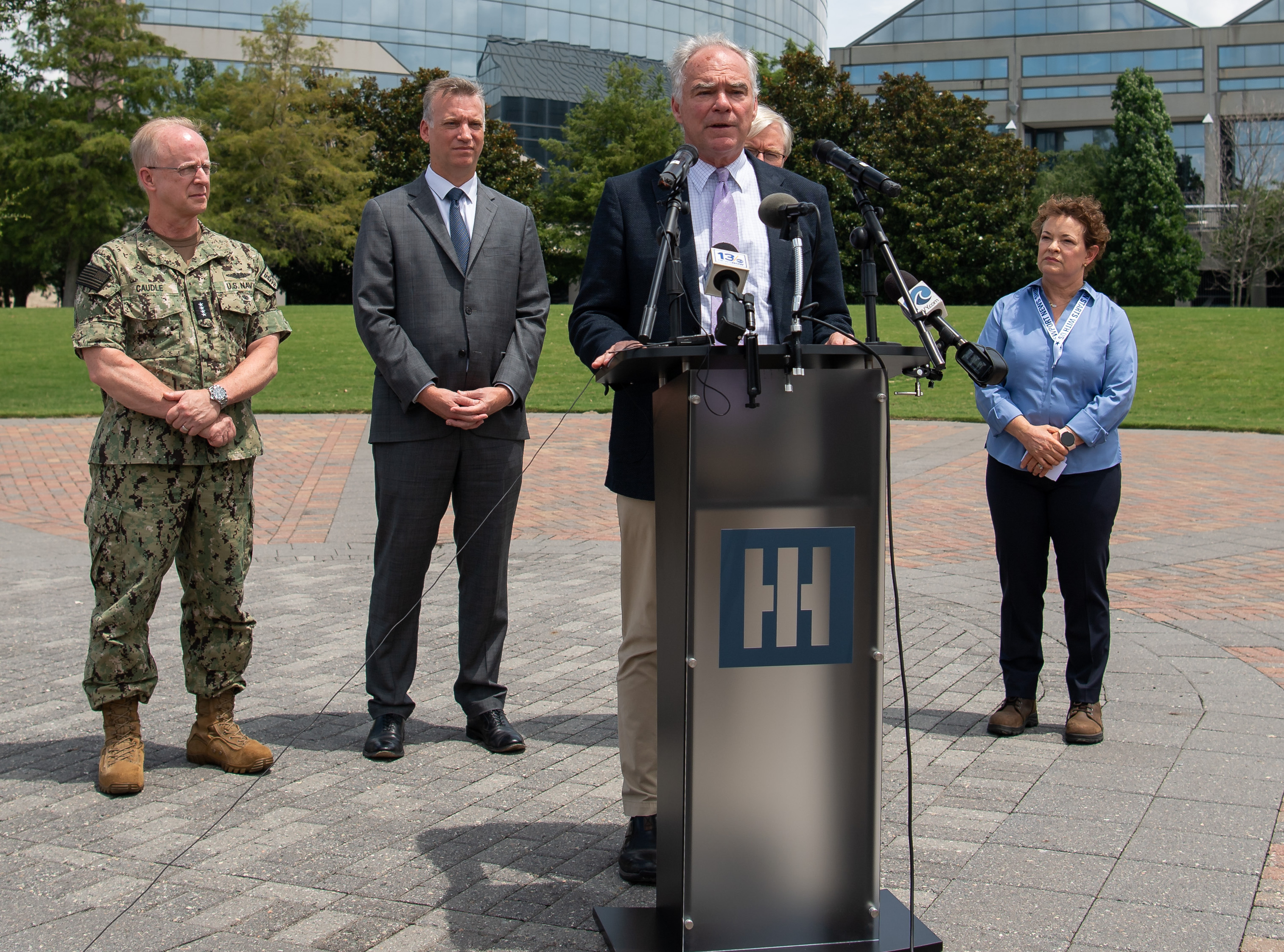
This post has been update with additional legislative actions from the Fiscal Year 2024 NDAA.
NEWPORT NEWS, Va. – The U.S. Senate took a tangible step forward to supply the Royal Australian Navy with its own nuclear attack boats with a new AUKUS bill that sets a framework to transfer Virginia-class attack boats to Canberra by the 2030s, Sen Tim Kaine (D-Va.) told reporters on Friday.
Standing in view of the hulk of the former aircraft carrier USS Enterprise (CVN-65) in Newport News, Kaine and Australian ambassador to the U.S. Kevin Rudd outlined legislation that emerged from the Senate Foreign Relations Committee Thursday to support Canberra having its own nuclear submarine fleet.
“I would argue that the new chapter in the relationship between the U.S., U.K. and Australia is every bit as exciting because it demonstrates again the capacity of the United States and other like-minded democracies to form alliances,” Kaine said.
“The first pillar will be the construction of Virginia-class subs, which are done here and in Connecticut. And then the subs, beginning of the 2030s, will transfer to Australia to enable Australia to take what they already do to promote regional security and do even more.”
The amendment to the State Department Authorization Act of 2023 approved the transfer of two Virginia attack boats to Australia with a third boat to be sold to Canberra via the State’s Foreign Military Sales program.
In addition, the amendment speeds up the technology clearance for AUKUS and relaxes commercial export controls for the material related to the program.
The amendment was part of a six-week-long legislative push from the U.S. led by Navy Undersecretary Erik Raven, who came to Congress to secure the legislative backing for the AUKUS boats to Australia, Kaine said.
“The Pentagon presented us with their proposal, and, over the course of the last six weeks, which is lightspeed in Senate time, we have worked very hard with the Armed Services Committee and the Foreign Relations Committee on both sides of Congress,” Kaine said.
The bill is set to head to the full Senate for a vote next week, he said.
While bipartisan enthusiasm for deepening ties with Canberra is high, questions about how the transfer of three to five U.S. Navy Virginia-class attack boats to the Royal Australian Navy will affect America’s attack sub inventory remain.

As of Friday, about a third of the Navy’s 51 nuclear attack boats are in maintenance due to backlogs in repair work in all four of the U.S. Navy’s public shipyards, a Navy official told USNI News. Likewise, HII and General Dynamic Electric Boat will continue to build less than two Virginia boats a year until 2028, USNI News reported in March.
Under the Navy’s latest long-range shipbuilding plan, by the time the first Virginia nuclear sub would be transferred to the Royal Australian Navy, the U.S. could be down to 46 attack boats. The Navy’s long-term goal is to have a force of 66 attack boats.
“We are going to give them existing Block III or Block IV Virginias, and then they’re gone,“ naval analyst and former submariner Bryan Clark who wrote a recent report on undersea warfare told USNI News on Friday.
“Considering submarines in maintenance, that could be up to 10 to 20 percent of the available nuclear attack boat fleet.”
Kaine and Sen. Kevin Cramer (R-N.D.) sponsored an amendment to the Senate version of the Fiscal Year 2024 National Defense Authorization Act that laid out a list of stipulations that would have to be satisfied in order for the U.S. to transfer the attack boats to the Royal Australian Navy, according to the filing.
The conditions in the bill say that the Australian would have to be able to maintain at least four U.S. Virginia-class and one U.K. Royal Navy Astute-class nuclear attack boat before the Navy would transfer a Virginia to Australia. Other conditions include the maintenance and crewing of the boats including their disposal and that the interests of Australia align with the U.S. Kaine also included an amendment to study how to effectively feather in the AUKUS boats into the U.S. submarine base.
Some Republicans in the House and Senate want the Biden administration to invest more into shipbuilding infrastructure to support the additional submarine construction and maintenance needed to support AUKUS and could make it a component of future approvals, two legislative sources familiar with the deliberations told USNI News.
Criticism of the sale of the attack boats has been mostly muted.
“The AUKUS agreement has the potential to be transformative for the United States, Australia and the United Kingdom. However, we must match words with tangible actions in order to realize the near- and long-term deliverables of the agreement,” Sen. Jim Risch (R-Idaho), the ranking member foreign relations committee, said in a statement following the release of the bill on Thursday.
A leaked December letter from Senate Armed Services Committee chair Sen. Jack Reed (D-R.I.) and ranking member Sen. James Inofe (R-Okla.) to the White House expressed much more pointed concern over overstressing the submarine industrial base.
“We are concerned that what was initially touted as a ‘do no harm’ opportunity to support Australia and the United Kingdom and build long-term competitive advantages for the U.S. and its Pacific allies, may be turning into a zero-sum game for scarce, highly advanced U.S. SSNs,” wrote the pair, according to Breaking Defense.
Raven told USNI News Friday the Navy’s level of investment in the Fiscal Year 2024 budget was set to address the backlog.
“In terms of maintenance and new production here in the United States, I’ve been working very closely with not only Newport News Shipbuilding but Electric Boat to make sure that we have the investments necessary in areas such as workforce, supply chain and many other investments to make sure that we are getting these very crucial programs on track on the maintenance front,” he told USNI News.
“We are not where we want to be today. However, if you look at the President’s budget for Fiscal Year 24… it includes new investments, totaling $1.7 billion over the next several years to get at some of these maintenance delays that we’re seeing.”
Rudd told reporters he was optimistic about the outcome of the U.S. legislation needed to make the Australian attack boats a reality.
“I know the business of making sausages can sometimes be untidy, messy, prolonged, but ultimately, there’s a sausage at the end,” he said.





